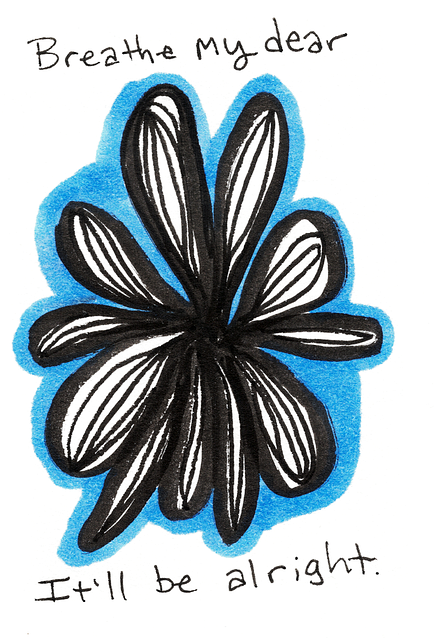Burnout, aka "Golden Cancer," plagues healthcare professionals due to workload, emotional demands, and lack of support. Mind Over Matter techniques, compassion cultivation through mindfulness, empathy training, and mood management are effective therapies. Golden Cancer Issues Therapy (GCIT) tackles root causes via open communication, risk assessment, and resilience building. Preventative measures like work-life balance, self-care, and peer support, coupled with awareness campaigns, reduce workload and enhance well-being. Fostering a supportive culture prioritizes mental health, enhances emotional intelligence, and navigates the complex landscape of GCIT.
Healthcare provider burnout is a growing concern, often referred to as the ‘Golden Cancer’ due to its insidious nature and profound impact. This article delves into understanding this crisis, exploring underlying causes, and presenting effective therapy approaches. We discuss preventative measures for daily practice and emphasize fostering supportive environments to cultivate a culture of care. By addressing these issues, we aim to provide practical strategies to combat burnout and promote the well-being of healthcare providers.
- Understanding Burnout in Healthcare Providers: Recognizing the Golden Cancer
- Exploring Underlying Causes: Unraveling the Issues
- Effective Therapy Approaches: Treating Burnout at its Core
- Implementing Preventative Measures: Strategies for Daily Practice
- Fostering Supportive Environments: Cultivating a Culture of Care
Understanding Burnout in Healthcare Providers: Recognizing the Golden Cancer

Burnout among healthcare providers is a pressing issue that often goes unnoticed until it manifests as what some refer to as the “Golden Cancer.” This insidious condition affects medical professionals across various specialties, leading to decreased job satisfaction, increased stress levels, and, in severe cases, a decline in the quality of patient care. Recognizing burnout early on is crucial, as it can stem from a myriad of factors, including excessive workload, emotional demands, and a lack of support systems.
The “Golden Cancer” issues arise when healthcare providers struggle to manage their mental health and well-being, often prioritizing patients’ needs over their own. Mind Over Matter principles emphasize the power of cognitive reframing and positive affirmations to combat stress and negative thought patterns. Compassion cultivation practices, such as mindfulness meditation and empathy training, have proven effective in reducing burnout by fostering a sense of connection and understanding among medical professionals. Additionally, mood management techniques play a pivotal role in maintaining emotional resilience, enabling healthcare providers to better navigate the challenges inherent in their noble yet demanding profession.
Exploring Underlying Causes: Unraveling the Issues

Healthcare provider burnout is a complex phenomenon that demands a deep exploration of its underlying causes. Unraveling these “golden cancer issues” involves more than just identifying hours worked or administrative burdens. It requires a multifaceted approach, incorporating both structural and individual factors.
While workload remains a significant contributor, other critical elements include lack of control over work processes, insufficient rewards and recognition, and a toxic work environment. Incorporating Mind Over Matter principles, cultivating emotional intelligence, and advocating for robust mental health policy analysis can help address these issues head-on. By focusing on the holistic well-being of healthcare providers, we can create a more sustainable and compassionate healthcare system.
Effective Therapy Approaches: Treating Burnout at its Core

Burnout prevention requires a multifaceted approach, and effective therapy plays a pivotal role in addressing its root causes. Golden Cancer Issues Therapy (GCIT), a specialized form of counseling, has emerged as a powerful tool to combat burnout among healthcare providers. GCIT focuses on identifying and managing the psychological and emotional factors contributing to burnout, treating it at its core rather than merely alleviating symptoms. By facilitating open communication strategies, this therapy encourages professionals to express their experiences, challenges, and concerns in a safe and non-judgmental environment.
Risk Management Planning for Mental Health Professionals is another essential aspect integrated into GCIT. Through comprehensive risk assessments, mental health professionals can identify potential burnout triggers within their work environments. This proactive approach allows them to implement tailored strategies to mitigate risks, enhancing resilience against burnout. By combining effective therapy techniques with robust risk assessment and management practices, healthcare providers are equipped to navigate the demands of their profession while safeguarding their well-being.
Implementing Preventative Measures: Strategies for Daily Practice

Healthcare provider burnout is a pressing issue that requires proactive strategies to address it effectively. Implementing preventative measures is crucial for maintaining a healthy work environment and ensuring quality patient care. Daily practice can incorporate various strategies such as setting clear boundaries between professional and personal life, prioritizing self-care activities like regular exercise, adequate sleep, and engaging in hobbies outside of work. These practices foster resilience building, enabling healthcare providers to better manage stress and prevent burnout.
Additionally, institutions should promote a culture that encourages open communication and provides access to mental health resources. Public awareness campaigns development focused on identifying golden cancer issues early can alleviate some of the workload while enhancing overall well-being. Regular check-ins with colleagues, peer support groups, and mindfulness exercises have proven beneficial in cultivating a supportive environment. By integrating these measures into daily routines, healthcare providers can improve their resilience, maintain higher job satisfaction, and ultimately provide better therapy for patients facing various health challenges, including mental health concerns.
Fostering Supportive Environments: Cultivating a Culture of Care

Creating supportive environments is a powerful strategy to combat burnout among healthcare providers, especially in navigating the complex landscape of patient care and emotional challenges. This involves fostering a culture that prioritizes care not just for patients but also for each other. In this supportive environment, mental health professionals can openly discuss their experiences, share insights, and offer guidance without fear of judgment, forming a tight-knit community. Such a culture promotes emotional intelligence, encouraging practitioners to recognize and manage their emotions effectively while empathizing with patients’ golden cancer issues therapy journeys.
By implementing these practices, healthcare organizations can enhance risk management planning for mental health professionals, ensuring they have the necessary tools to maintain resilience in the face of high-stress situations. This supportive culture serves as a shield against burnout, allowing professionals to provide optimal care while safeguarding their well-being, ultimately improving patient outcomes and job satisfaction.
Healthcare provider burnout is a pressing issue, often referred to as the “Golden Cancer,” due to its insidious nature and profound impact on patient care. By understanding the underlying causes, from work-life imbalance to emotional exhaustion, we can develop effective therapy approaches targeting the core issues. Implementing preventative measures in daily practice, such as mindfulness and self-care strategies, is crucial for fostering resilience. Moreover, creating supportive environments that prioritize communication, collaboration, and a culture of care can significantly mitigate burnout risks. Together, these strategies aim to address the Golden Cancer, ensuring healthcare providers can continue to deliver quality patient care without succumbing to professional exhaustion.











